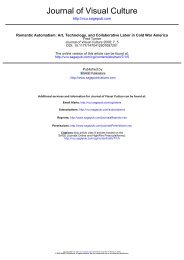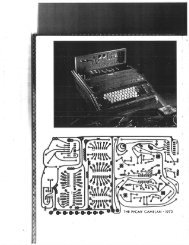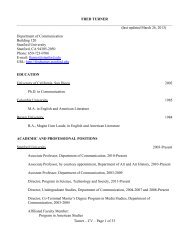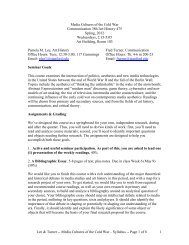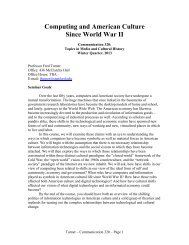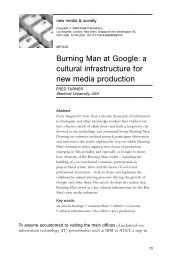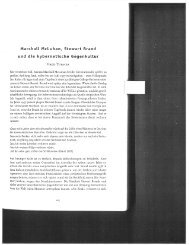The Family of Man and the Politics of Attention in ... - Public Culture
The Family of Man and the Politics of Attention in ... - Public Culture
The Family of Man and the Politics of Attention in ... - Public Culture
You also want an ePaper? Increase the reach of your titles
YUMPU automatically turns print PDFs into web optimized ePapers that Google loves.
<strong>Public</strong> <strong>Culture</strong><br />
60<br />
<strong>Man</strong> Friends Government<br />
Universal Work Competition<br />
Timeless Home Invention<br />
Love Worship Beauty<br />
Create Peace Migration<br />
Birth Conflict Fear<br />
Death Abode Hope<br />
<strong>Family</strong> Hunger Cooperation<br />
Word Pestilence Dream<br />
Fa<strong>the</strong>r Communication Woman<br />
Mo<strong>the</strong>r Ancesters [sic] Descendents [sic] 8<br />
With <strong>the</strong> assistance <strong>of</strong> Lange <strong>and</strong> many o<strong>the</strong>rs, Steichen <strong>and</strong> Miller ultimately<br />
reviewed 2 million images. <strong>The</strong>y w<strong>in</strong>nowed <strong>the</strong>se to 10,000 <strong>and</strong> <strong>the</strong>n, work<strong>in</strong>g <strong>in</strong><br />
a small l<strong>of</strong>t on Fifty- Second Street, to <strong>the</strong> 503 photographs that ultimately hung<br />
<strong>in</strong> <strong>the</strong> museum. Steichen all but prohibited abstract images from <strong>the</strong> exhibition.<br />
Instead, he drew primarily on <strong>the</strong> realistic snapshot aes<strong>the</strong>tics <strong>of</strong> contemporary<br />
photojournalism. Steichen <strong>and</strong> Miller’s f<strong>in</strong>al selection <strong>in</strong>cluded images by Edward<br />
Weston, Ansel Adams, Robert Capa, <strong>and</strong> Lange; it also featured images by photographers<br />
who through less ma<strong>in</strong>stream work were soon to make <strong>the</strong>ir names,<br />
such as Robert Frank, Diane Arbus, <strong>and</strong> Bill Br<strong>and</strong>t. Steichen thumbed through<br />
literature <strong>and</strong> journalism too, seek<strong>in</strong>g quotations to accompany <strong>the</strong> images on <strong>the</strong><br />
museum’s walls. He turned to his bro<strong>the</strong>r- <strong>in</strong>- law, poet Carl S<strong>and</strong>burg, for help.<br />
S<strong>and</strong>burg wrote a prologue for <strong>the</strong> exhibition; its walls ultimately also featured<br />
passages from <strong>the</strong> Bible, Navajo Indian lore, <strong>and</strong> even <strong>the</strong> writ<strong>in</strong>gs <strong>of</strong> acerbic<br />
philosopher Bertr<strong>and</strong> Russell.<br />
When <strong>the</strong> exhibition f<strong>in</strong>ally opened <strong>in</strong> 1955, <strong>the</strong> museum <strong>and</strong> <strong>the</strong> press made<br />
a great deal <strong>of</strong> Steichen <strong>and</strong> Miller’s editorial efforts. Most reviewers loved <strong>the</strong><br />
show. <strong>Man</strong>y lauded Steichen as a sort <strong>of</strong> author, who spoke <strong>in</strong> what he <strong>and</strong> reviewers<br />
alike called <strong>the</strong> “universal language” <strong>of</strong> photography, <strong>and</strong> <strong>the</strong> exhibition as<br />
a text, an essay even. 9 Over <strong>the</strong> years, however, critics have come to decry what<br />
<strong>the</strong>y see as Steichen’s transposition <strong>of</strong> <strong>the</strong> photo- essay from magaz<strong>in</strong>e page to<br />
museum wall. For <strong>the</strong> past forty years at least, most have agreed with journalist<br />
Russell Lynes’s 1973 account, <strong>in</strong> which he wrote that <strong>The</strong> <strong>Family</strong> <strong>of</strong> <strong>Man</strong> “was<br />
a vast photo- essay, a literary formula basically, with much <strong>of</strong> <strong>the</strong> emotional <strong>and</strong><br />
8. Lange, letter, January 16, 1953, 24.<br />
9. Photography, said Steichen, “communicates equally to everybody throughout <strong>the</strong> world. It is<br />
<strong>the</strong> only universal language we have, <strong>the</strong> only one requir<strong>in</strong>g no translation.” Edward Steichen, “Photography:<br />
Witness <strong>and</strong> Recorder <strong>of</strong> History,” Wiscons<strong>in</strong> Magaz<strong>in</strong>e <strong>of</strong> History 41, no. 3 (1958): 160.



